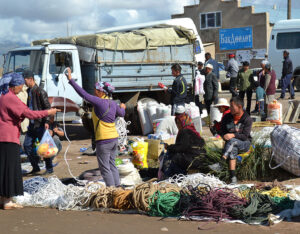European National Policies Series – Denmark and Central Asia

Denmark has in recent years enhanced its political and economic ties to Central Asian states. Political and economic interests drive Denmark’s enhanced political attention to the region, which ultimately aims to promote political stability and economic prosperity throughout Europe. More specifically, Danish interest in Central Asia is the result of the ongoing demand for oil, gas, hydrocarbon diversification, military transit routes to and from Afghanistan and the threat of instability in Central Asia.
In 2009 Denmark adopted a Central Asia strategy(1), which outlines Denmark’s policy objectives towards the region. ‘The Central Asian strategy focuses primarily on Kyrgyzstan and Tajikistan and seeks to promote democracy and human rights, rule of law and good governance including the fight against corruption’. The strategy includes bilateral financial assistance to Central Asia, which consists of €3.6 million (for the 2009 to 2012 period) and is consistent with the European Union’s (EU) overall strategy for the region.
The overall aim of Denmark’s Central Asia strategy is to enhance stability and security; combat poverty; and to promote cooperation within the region, as well as with the EU. In recognition of the strategic importance of Central Asia, Denmark is currently working on a new framework for the five Central Asian republics.
Tajikistan and Kyrgyzstan are the main Central Asian recipients of Danish development assistance, with Kazakhstan having also received development assistance in preparation for the state’s chairmanship of the Organization for Security and Cooperation in Europe (OSCE) in 2010. Trade and investment links make Kazakhstan the most important partner in the region for Denmark, as trade with Kyrgyzstan and Tajikistan is very limited. The political and economic relations with Uzbekistan and Turkmenistan are minor, due to the lack of political and market oriented reforms in such states.
Political relations and values
Since the dissolution of the Soviet Union in 1991, Denmark has pursued an active agenda of foreign policy towards the former Soviet states, including the five Central Asian states. This has taken place bilaterally, but also through Denmark’s support to the North Atlantic Treaty Organisation (NATO), the EU and the United Nations (UN).
Denmark’s development support to Central Asia however, has always been relatively modest, as a political framework for the region was not adopted until 2009. The large majority of Denmark’s funds to development assistance in the post-Soviet states are channelled to Eastern Europe and the South Caucasus, as part of the Danish Neighbourhood Policy.(2) Sweden has historically been the largest contributor of development aid to Central Asia among the Nordic countries. Since 2010 however, Sweden has cut back its bilateral support to Kyrgyzstan and Tajikistan. In contrast to this, Finland has allocated €50 million to the Wider Europe Initiative from 2011 to 2014, which covers Eastern Europe, the Caucasus and Central Asia. Norway is also engaged in Central Asia and from 2009 to 2011 has allocated €7.3 million in development assistance to Central Asia.
Given its population, Denmark is proportionally one of the biggest net contributors of foreign aid in the world. An important element of such development assistance has been to support areas such as human rights, the rule of law and democratisation, as it is believed that political stability and economic prosperity ultimately corresponds with Danish interests. In terms of ‘hard power’, Denmark is an active player in Afghanistan, which was exemplified in 2002 when Denmark decided to join a broad coalition of countries that entered into the war. Denmark has subsequently allocated troops and supplied materials to the International Security Assistance Force (ISAF) and NATO forces in Afghanistan.
Such overall policy objectives have guided Denmark’s engagement and commitment to Central Asia, where it also seeks to contribute to a stable and economically prosperous region. This can only be achieved however, if the Central Asian republics start gradually a political and economic reform process.
To support such a process of reform, Denmark is committed to underpin the democratic process in the five Central Asian states. In practice, this is carried out with the support of the EU and the OSCE, but also on a bilateral basis. Danish development assistance targets the promotion of human rights, democratisation and good governance. Danish bilateral support is especially channelled to Tajikistan and Kyrgyzstan via the cooperation with domestic (primarily the Institute for Human Rights and International Media Support) and international partners (the OSCE, Eurasia Foundation and United Nations Economic Commission for Europe (UNECE)).
Denmark acknowledges that the supportive role it can play in Central Asia has its limits. Denmark has been an active supporter of the EU-Central Asia strategy since 2007 and also supports the OSCE. As a consequence of this, Denmark has allocated extra budgetary funding to the OSCE academy in Bishkek and the police mission to Kyrgyzstan following the unrest in 2010. Denmark supports the OSCE’s centres and field missions in Central Asia and is a firm backer of the Office for Democratic Institutions and Human Rights (ODHIR) that is engaged in election monitoring and supporting legislative reforms in Central Asia.
On the political level in Denmark, there has been a distinct fear that political and social tensions in Central Asia could turn into ethnic clashes or even military conflicts, which subsequently could destabilise the region. The former Danish foreign minister, Per Stig Møller, paid a visit to Kazakhstan and Tajikistan in 2009. This was the first time a Danish minister had visited the Central Asian region, and as such, the visit would later result in the Danish Central Asia strategy. Since the visit of Per Stig Møller, there have been several meetings with Central Asian states on an ambassadorial level.
The Danish embassy in Russia is responsible for covering Denmark’s diplomatic relations with the five Central Asian states. Kyrgyzstan and Kazakhstan’s diplomatic relations with Denmark are managed via their embassies in Germany, whereas the Tajik embassy in the UK attends to bilateral matters arising with Denmark. Uzbekistan and Turkmenistan do not have ambassadors appointed to Denmark, but visa applications to Denmark can be managed at their embassies in Berlin. Denmark moreover has entered into an agreement with Germany for visa applications from Kyrgyzstan, Tajikistan, Turkmenistan and Uzbekistan. Visa applications from Kazakhstan are managed via the Danish embassy in Moscow.
Trade and energy
In recent years Denmark’s commerce with Kazakhstan has increased, especially within the energy sector. In 2011 there was an increase in trade between Denmark and Turkmenistan. Uzbekistan has traditionally been Denmark’s second largest commercial partner in Central Asia, however the export of goods and services to the country has stagnated more recently. Trade and investment relations with Kyrgyzstan and Tajikistan furthermore are very limited.
Kazakhstan was Denmark’s 78th biggest export market in 2011, as the country imported Danish goods worth €48 million. Danish exports to Kazakhstan have however improved significantly during the last decade and there was a 5.1 percent increase in exports in 2011 on the previous year. Danish trade with Kazakhstan is focused on energy, clean technology, infrastructure, agriculture and consumer goods. The biggest product line that was exported to Kazakhstan in 2011 was chemical materials and related products. Danish imports from Kazakhstan amounted to €75 million in 2011, 17.1 percent less than 2010. The majority of such imported goods are oil and oil-related products, which amount to €60 million.
Danish exports to Uzbekistan are limited and were only €4.2 million in 2011, a 53.3 percent decrease from 2010. The biggest export product from Denmark to Uzbekistan is chemical materials and related products. Danish imports of Uzbek goods are near zero and mainly consist of fruit and vegetables.
Danish exports to Turkmenistan amounted to €4.4 million in 2011, which is an increase of two percent compared to 2010. The biggest export product to the country is food ingredients. Danish imports from Turkmenistan amounted to €13.6 million in 2011, which largely consisted of oil related products.
Danish exports to Kyrgyzstan saw an increase by 72.2 percent from 2010 to 2011. This trend seems to have continued in 2012, where exports in the first quarter have increased a further 59.8 percent since 2011. In total, Denmark exported €1.7 million worth of products to Kyrgyzstan in 2011. Danish imports of Kyrgyz’s products are very limited, and primarily consist of fruit and vegetables. Trade between Denmark and Tajikistan is altogether very limited with Denmark exporting a mere €400,000 worth of products to Tajikistan in 2011.(3)
The Danish brewery Carlsberg has made investments in Uzbekistan and Kazakhstan. Carlsberg currently employs 400 people in Uzbekistan and has an annual capacity of 1.3 hectolitres of beer, produced and sold for domestic consumption. Carlsberg has operated in Kazakhstan since 2002 and is the biggest operator in the domestic market at present.
Maersk Oil began working in Kazakhstan in 2000 when the company acquired 60 percent interest in the onshore Temir Block. In 2002, Maersk Oil also acquired 60 percent of the Dunga Block. Average oil production from the Dunga field is currently some 6,000 barrels a day. In addition, Maersk is expected to invest USD 1 billion in the Dunga field. Aside such examples, Danish companies are reluctant in general to invest and operate in Central Asia, due to the unstable political environment.
Security
Denmark currently has 720 troops deployed in Afghanistan, which operate in the Helmand province. Denmark’s security strategy has been to tone down the military efforts since 2012, focusing instead on training Afghan forces and supporting civil society in its endeavour to stabilise the country. Denmark will continue this process whilst Danish military actions are phased out eventually before 2015. In view of the enhanced risk of destabilisation, armed conflicts, extremism and spill-over from Afghanistan, Denmark is also concerned with the security situation in Central Asia. As a result Denmark has attached increased importance to the security situation in the Central Asian region in the last decade.
Civil war in Tajikistan from 1992 to 1997 and ethnic clashes in Kyrgyzstan in 2010, have underlined that stability can be fragile in Central Asia and have laid bare some of the internal challenges the five Central Asian states deal with. Border disputes in the Fergana Valley, and questions regarding scarcity of water pose unsolved problems that threaten to knock regional stability. In addition to this, security threats from Afghanistan are a consideration – one that cannot be presumed to remain contained following the withdrawal of NATO forces.
The Danish Central Asia framework is established to bolster the international community’s efforts to counter some of such security issues. Denmark focuses especially on Tajikistan and Kyrgyzstan: both countries are vulnerable to negative spill-over effects from Afghanistan, foremost radicalism and drug trade. Denmark supports the OSCE in its border security projects and in 2010, the Danish government decided to allocate €1.5 million in extra funds to Tajikistan to enhance border management and the flow of refugees from Afghanistan. The projects are implemented in cooperation with the OSCE and the Danish Refugee Council.
Development assistance
Denmark implemented several aid projects in Kyrgyzstan, Tajikistan and to a limited extent in Kazakhstan. Since the 1990s, Danish support to Central Asian states has primarily been channelled through the OSCE and other multilateral organisations. Denmark’s involvement in Central Asia was quite limited until 2007 however. As a result of the enhanced prioritisation of the five Central Asian states, Denmark has in recent years increased its development assistance to the region. Danish aid to Central Asia generally aims to contribute to security and stability, which includes increased border security and a strengthening of police capacities. Denmark’s normative agenda seeks to promote a democratic development of society with respect for human rights.
From 2009 to 2012 Danish support to the region amounts to a total of €3.6 million(4). Danish aid and support was allotted to the countries that show political commitment to conduct political and economic reforms. The main focus for such support is on Kyrgyzstan and Tajikistan, since both states have exhibited a degree of political commitment in cooperating with international partners. This bilateral support to Central Asia has been previously a part of the Danish Neighbourhood programme, however it has been proposed recently that the Danish contribution to the region in the future will be defined separately and financed from another budget line. This adjustment has been made in order to align the development assistance with regional divisions Brussels has made and various programmes the EU is supporting in Central Asia. The Danish support to Central Asia will be financed through the stabilisation and conflict prevention budget.
Following the ethnic clashes in 2010 between Kyrgyz and Uzbeks in Kyrgyzstan, Denmark has supported a police mission in southern Kyrgyzstan via its support to the OSCE driven Community Security Initiative. In addition to this support, Denmark has in cooperation with the Eurasia Foundation allocated funds to conflict prevention in southern Kyrgyzstan. In order to tackle some of the problems which were envisaged following the unrest in Kyrgyzstan, Denmark has supported financially a number of projects in the civil society sphere, including the professionalisation of Kyrgyz media (€114,625), the democratisation of media with a special focus on youth and civil society (€423,690) and the promotion and protection of human rights (€86,660). Denmark has allocated additionally €115,000 to the Danish Refugee Council, which in cooperation with local and international nongovernmental organisations (NGOs) will strive to enhance the judicial and economic conditions for minority groups in southern Kyrgyzstan.
Tajikistan has been the target of Danish development assistance since 2010. Within the field of human rights and good governance, Denmark has financially supported the Ombudsman institution in Tajikistan to the tune of €133,300. The project aims at supporting the human rights commissioner (ombudsman) in Tajikistan in becoming a well-established institution and to build capacity in applying international human rights standards, raising public awareness on human rights issues and reaching out to different parts of the country. Furthermore, Denmark has supported projects in Tajikistan that seek to enhance border surveillance, border control and counter anti-radicalisation.
Conclusion
As a result of Central Asia’s increased strategic importance, Denmark in recent years has enhanced its political ties to the region. Denmark’s involvement in Central Asia is driven by commercial and security related interests. In terms of security, the increased emphasis on the region is fuelled by a fear of destabilisation, armed conflicts and extremism. Denmark’s military engagement in Afghanistan has further underlined the need to enhance security in Central Asia due to threat of a potential spill-over from Afghanistan. On energy, Denmark is interested in diversifying the energy transit routes to Europe. The Central Asian states are an option in this endeavour as they can help decrease dependence on Russian gas and oil transit routes.
The 2009 framework of Denmark’s Central Asia Strategy forms the basis of political relations, aid assistance and the commercial interests to the five Central Asian states. The Danish government is currently working on a new strategic framework, which will improve the administration of the Central Asian strategy. This initiative underlines the increased importance of Central Asia in for Denmark. Policies towards Central Asia are in recognition of limited political and economic clout in the region, in accordance with the EU’s Central Asia strategy. Denmark’s policy is therefore to offer political and economic assistance in areas where help is needed in order to provide added value and avoid duplication of work.
- Udenrigsministeriet,Centralasien-Strategi. Danmarkspolitik over for Centralasien, 2009 http://um.dk/da/~/media/UM/Danish-site/Documents/Danida/Det-goer-vi/EUs-naboer/Centralasienstrategi.ashx, accessed 10 August 2012.
- Danish Ministry of Foreign Affairs, Strategy of the Danish Neighbourhood Programme 2008-2012, 2007, http://um.dk/en/~/media/UM/English-site/Documents/Danida/Activities/EUs-Neighbours/StrategyNeighbProgr20082012.ashx, accessed 10 August 2012.
- Trade figures provided by the Danish Ministry of Foreign Affairs.
- Udenrigsministeriet,op. cit,http://um.dk/da/~/media/UM/Danish-site/Documents/Danida/Det-goer-vi/EUs-naboer/Centralasienstrategi.ashx, accessed 10 August 2012.



![shutterstock_1240181551 [Omgezet]](https://eucentralasia.eu/wp-content/uploads/2024/10/shutterstock_1240181551-Omgezet-300x248.jpg)



